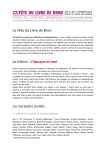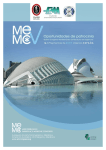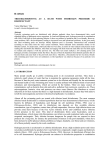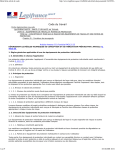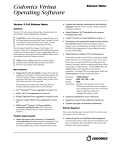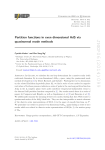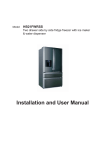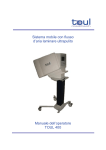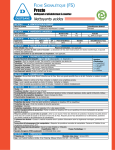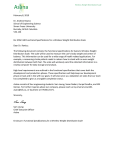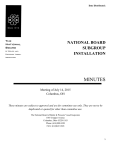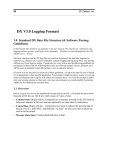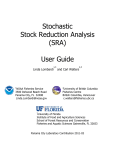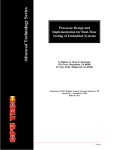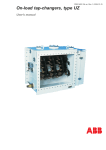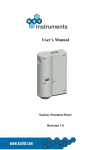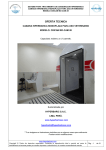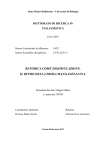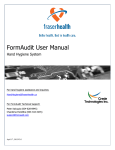Download Technical report - Rubicon Research Repository
Transcript
http://archive.rubicon-foundation.org 85 Diving and Hyperbaric Medicine Volume 42 No. 2 June 2012 Technical report Hyperbaric critical care patient data management system Peter Kronlund, Daniel Olsson and Folke Lind Abstract (Kronlund P, Olsson D, Lind F. Hyperbaric critical care patient data management system. Diving and Hyperbaric Medicine. 2012;42(2):85-87.) A patient data management system (PDMS) has been used for years in the intensive care unit (ICU) at the Karolinska University Hospital to provide bedside or remote clinical patient documentation and information. Data from monitors, mechanical ventilators and syringe pumps are fed into a central clinical information management system to monitor, display trends and record data of vital parameters, ventilator settings and drugs. In order to continue routine critical care monitoring and recording during hyperbaric oxygen therapy (HBOT), without endangering the safety demands of hyperbaric procedures, we have modified the PDMS system for hyperbaric use. Via an ethernet box placed inside the chamber, data is transmitted to the Clinisoft™ system through the local area network. By standardised risk-analysis procedures, in close cooperation between the hyperbaric and biomedical engineering departments, the chamber producer and the notifying body (Germanischer Lloyd), the ethernet box was modified to receive full safety approval by all parties. The PDMS is now functioning routinely during HBOT for intensive care patients so that data can be seen bedside and followed on-line in the ICU. Data are also continuously stored on the clinical information management system for later clinical or research purposes. Work continues to obtain CE approval for hyperbaric use for modern syringe pumps and mechanical ventilators connected to the PDMS system. Improved documentation of ICU care will improve quality of care during HBOT and facilitate research and development in hyperbaric medicine. Key words Hyperbaric oxygen therapy, patient monitoring, equipment, computers, data, risk assessment, review article Introduction Treatment of critically-ill victims of carbon monoxide poisoning, air embolism, traumatic crush injuries and severe, necrotizing soft-tissue infections with hyperbaric oxygen therapy (HBOT) calls for an array of technical medical equipment to be modified for hyperbaric use.1–3 Intubated, septic patients with multi-organ failure require not only experienced intensive care staffing but also a number of technical and equipment considerations. Mechanical ventilation in the hyperbaric environment requires close monitoring of blood gases and end-tidal CO2. Vital parameter monitoring includes electrocardiogram, intravascular pressures, pulse oximetry and urinary output. Critically ill patients have need for continuous fluid, electrolyte and drug infusions. Blood products are frequently given postoperatively. The intubated patient has need of sedation and suctioning. Syringe pumps are required for accurate delivery of potent drugs such as vasopressors and insulin. Medical technical devices in the Karolinska Central Intensive Care Unit (ICU) such as ventilators, infusion/ syringe pumps and patient monitoring systems are nowadays connected to a clinical information management system (Clinisoft; CentricityTM Critical Care, GE Healthcare). The ethernet box (E-box) placed bedside in the intensive care unit converts the serial communication output from the connected medical technical equipment to a TCP/IP protocol and transmits the data to the Clinisoft system through the normal computer network. The E-box has a total of eight available connectors for input of data from mechanical ventilator, syringe pumps, etc. Data can be seen bedside as well as in other, more distant settings, for example, during ward rounds and, in a later phase, as stored data for trend analyses or research. The nurse and doctor can also manually enter dispensed medications, etc., into the system from their computer station. In the past, a blank period with two or Figure 1 Critical care nurse and intubated patient in the hyperbaric chamber. ethernetbox (lower left) connected to a Datex monitor (GE healthcare); the slave screen above the monitor displays ECG, arterial blood pressure and oxygen saturation; E-box has seven vacant connectors for future use. http://archive.rubicon-foundation.org 86 Diving and Hyperbaric Medicine Volume 42 No. 2 June 2012 more hours’ loss of information occurred due to disconnected PDMS monitoring and recording as the patient went to the operating theatre, to the radiology department or for HBOT. We have now modified an E-box for use under hyperbaric conditions in the Karolinska hyperbaric chamber (HAUX 3500) to allow continuous routine monitoring and recording with the PDMS during critical care HBOT (Figure 1). Risk assessment A risk-analysis group was created in cooperation between the hyperbaric and biomedical engineering departments of the Karolinska University Hospital to investigate whether the E-box could be safely used under hyperbaric conditions. The participants were chosen from different professions with the aim of combining hyperbaric knowledge with that of biomedical engineering and quality assessment. A risk analysis was performed according to the ISO 14971 standard with pressure test protocols, technical documentation of modifications for its intended use and an evaluation of possible consequences which may occur when using the E-box in the hyperbaric environment. Several European Community directives and norms were considered by the group in this process.4–7 Modifications and tests The power supply unit was modified to work with the 12V current in the chamber (Figure 2). A standard DC 12V/ DC 5V reducer was chosen to function in the hyperbaric environment with a shielded metal case, over-temperature Figure 2 Ethernet mainboard (lid removed); the DC 12V/DC 5V reducer is the rectangular device in the lower part of the box connected to the 12V cable at right and flat 5V cable at left protection and an extended operating temperature range (-40OC to +85OC). No increased risk of spark formation from the power supply unit was recognised by the risk-analysis group. The normal pressure for HBOT in ICU patients is 1.8 bar gauge pressure (284 kPa) with control of temperature and humidity through the air conditioning system in the chamber. The intended use inside our hyperbaric chamber could possibly involve larger changes in environmental conditions, i.e., pressure, humidity, temperature and oxygen levels. The maximum pressure in our ICU chamber is 3.0 bar gauge pressure (405 kPa, corresponding to 30 metres’ fresh water). The E-box was modified for its intended use by removing the circuit breaker and moulding the power supply cable into the chassis with a DC 12V/DC 5V reducer in order to avoid sparks (Figure 2). The power cord that is connected to the E-box is itself modified to suit the standard conduit in the chamber system. All cables are only attached and detached during normobaric ambient conditions, before and after HBOT. Functional tests of the E-box were performed electrically by the Biomedical Engineering Department during repeated, prolonged (60 minutes) and rapid bounce test pressurisations to 608 kPa as well as during 405 kPa pressurisations in the regular ICU chamber setting without any equipment problems or failures. An abbreviated Swedish text manual for hyperbaric use of the E-box, is pasted on its lid as shown in Figure 1. Risk acceptance Risk acceptance was thus accomplished and the advantages of the intended use of the E-box in the hyperbaric chamber were judged to exceed the identified risks. The major risk found was that the E-box would transfer corrupt or distorted information to Clinisoft, which is a risk taken by all ICU departments with the use of a PDMS system. The E-box can be used in the intended environment in the Karolinska ICU chamber without having to change the user manual, with the exception that all cables should be connected before HBOT. Deviations in PDMS function are reported to the Karolinska Biomedical Engineering Department, who reports to the producer who in turn would inform other users. So far this has not occurred during the three-year period Clinisoft has been in use at the Karolinska. Discussion Hyperbaric oxygen treatment of critically ill patients necessitates special considerations regarding technical solutions. By having close cooperation between the hyperbaric and biomedical engineering departments at the Karolinska, the chamber producer (HAUX Life Support) and the notifying body (Germanischer Lloyd), we have been able to gain full approval for a modified E-box for hyperbaric use. We have chosen to bring the equipment into the hyperbaric treatment room to allow best possible ICU care by the accompanying doctor and nurse, who can also http://archive.rubicon-foundation.org 87 Diving and Hyperbaric Medicine Volume 42 No. 2 June 2012 Figure 3 facilitate research and development in hyperbaric medicine. Nurse inside tender at the PDMS computer workstation Acknowledgements The authors wish to thank Farhang Naderi and Niklas Blomberg, Biomedical Engineering Department and Bengt Eriksson, MD, Medical Director of Hyperbaric Medicine, Department of Anaesthesia, Surgical Services and Intensive Care, Karolinska University Hospital, Stockholm, Sweden. References 1 2 3 4 access the PDMS system through their respective computer workstations inside the hyperbaric ICU chamber (Figure 3). At present, ventilator settings and given drugs are entered manually into the PDMS system. Most of these data will be automatically recorded in the future via the bedside chamber workstation. Blood gases taken and sent out of the chamber for analysis are automatically entered into the PDMS system. The E-box is CE marked as a registered medical device and approved for its intended use by the manufacturer (General Electric Healthcare) according to the directive for medical products (MDD) 93/42 EC.4 CE-marking indicates that a product conforms to a European technical specification called a ‘Harmonised European Norm’. Once a manufacturer has demonstrated that the product complies with the requirements of the relevant norm, he can affix the CE marking to the product, its packaging or delivery documentation. According to EU and Swedish regulations (SOSFS 2008:17), any modification for hyperbaric use will alter the product so that it is no longer CE marked, but is to be looked upon as an ‘in-house production’. As such, the modified E-box has received full safety approval for hyperbaric use at the Karolinska by the notifiying body Germanischer Lloyd. However, because the work was carried out in cooperation with the chamber manufacturer and the notifying body, the chamber and E-box in use at the Karolinska remain approved CE-marked medical devices. Work is in progress with other manufacturers to achieve hyperbaric compatibility and, if possible, full CE approval for syringe pumps and ventilators. This will allow routine intensive care monitoring to continue without interruption during HBOT, improving the quality of patient care, and 5 6 7 Lind F, Öhlén G, Lindén V, Eriksson B, Frostell C and reference group. ‘FOCUS’ report to Stockholm County Council on hyperbaric medicine; treatment with hyperbaric oxygen (HBO) at the Karolinska University Hospital, 2011. Available from: http//:karolinska.se/hbo Moon RE, Camporesi EM. Clinical care in extreme environments: at high and low pressure and in space. In: Miller RD, editor. Miller’s anaesthesia. Philadelphia: Churchill Livingstone; 2010. p. 2485-515. Weaver LK. Hyperbaric oxygen in the critically ill. Crit Care Med. 2011;39:1784-91. Council Directive of 14 June 1993 concerning medical devices 93/42/EEC. European Commission; 1993. 1993 Jul 12; OJ L . p. 169. Directive 97/23/EC of the European Parliament and of the Council of 29 May 1997 on the approximation of the laws of the Member States concerning pressure equipment. 1997 Jul 9; OJ L. p. 181. Available from: http://ec.europa.eu/enterprise/ policies/european-standards/harmonised-standards/pressureequipment/ European standard prEN 14931. Pressure vessels for human occupancy (PVHO) - Multiplace pressure chamber systems for hyperbaric therapy - Performance, safety requirements and testing; 2004. 1997 Jul 9; OJ L. p. 181. Available from: http://ec.europa.eu/enterprise/policies/european-standards/ harmonised-standards/pressure-equipment/index_en.htm Swedish regulation SOSFS [Swedish]. 2008; 1. Available from: http://socialstyrelsen.se/sosfs/2008-1 Submitted: 30 November 2011 Accepted: 25 January 2012 Peter Kronlund, CCP, RN, is a perfusionist, and Folke Lind MD, PhD, is senior consultant in Hyperbaric Medicine at the Department of Anaesthesia, Surgical Services and Intensive Care, Karolinska University Hospital, Stockholm, Sweden. Daniel Olsson is a biomedical engineer in the Department of Biomedical Engineering, Karolinska University Hospital. Address for correspondence: Folke Lind, MD, PhD Hyperbaric Medicine Dept of Anaesthesia, Surgical Services and Intensive Care Karolinska University Hospital Solna SE-161 67 Stockholm, Sweden Phone: +46-(0)8-5177-5557 Fax: +46-(0)8-5177-4170 E-mail: <[email protected]>




